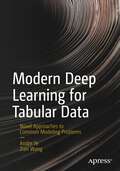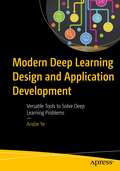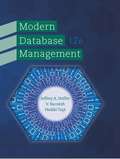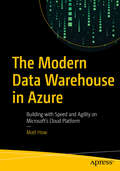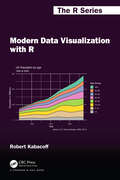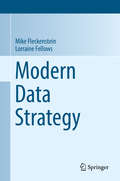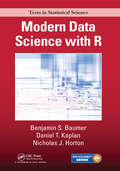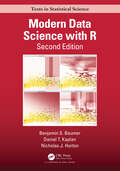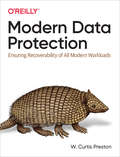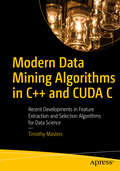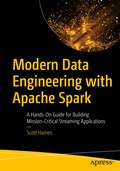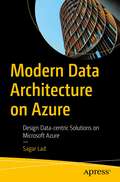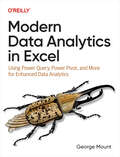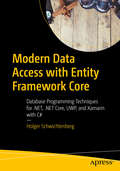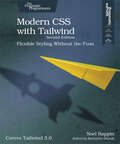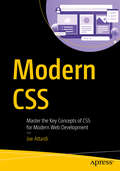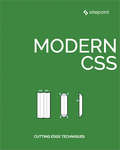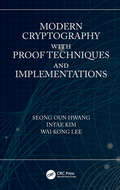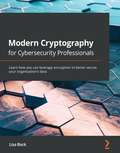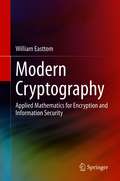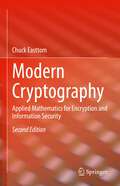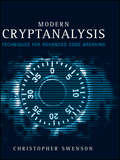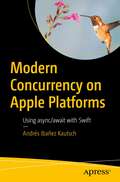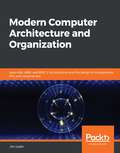- Table View
- List View
Modern Deep Learning for Tabular Data: Novel Approaches to Common Modeling Problems
by Andre Ye Zian WangDeep learning is one of the most powerful tools in the modern artificial intelligence landscape. While having been predominantly applied to highly specialized image, text, and signal datasets, this book synthesizes and presents novel deep learning approaches to a seemingly unlikely domain – tabular data. Whether for finance, business, security, medicine, or countless other domain, deep learning can help mine and model complex patterns in tabular data – an incredibly ubiquitous form of structured data. Part I of the book offers a rigorous overview of machine learning principles, algorithms, and implementation skills relevant to holistically modeling and manipulating tabular data. Part II studies five dominant deep learning model designs – Artificial Neural Networks, Convolutional Neural Networks, Recurrent Neural Networks, Attention and Transformers, and Tree-Rooted Networks – through both their ‘default’ usage and their application to tabular data. Part III compounds the power of the previously covered methods by surveying strategies and techniques to supercharge deep learning systems: autoencoders, deep data generation, meta-optimization, multi-model arrangement, and neural network interpretability. Each chapter comes with extensive visualization, code, and relevant research coverage. Modern Deep Learning for Tabular Data is one of the first of its kind – a wide exploration of deep learning theory and applications to tabular data, integrating and documenting novel methods and techniques in the field. This book provides a strong conceptual and theoretical toolkit to approach challenging tabular data problems.What You Will LearnImportant concepts and developments in modern machine learning and deep learning, with a strong emphasis on tabular data applications.Understand the promising links between deep learning and tabular data, and when a deep learning approach is or isn’t appropriate.Apply promising research and unique modeling approaches in real-world data contexts.Explore and engage with modern, research-backed theoretical advances on deep tabular modelingUtilize unique and successful preprocessing methods to prepare tabular data for successful modelling. Who This Book Is ForData scientists and researchers of all levels from beginner to advanced looking to level up results on tabular data with deep learning or to understand the theoretical and practical aspects of deep tabular modeling research. Applicable to readers seeking to apply deep learning to all sorts of complex tabular data contexts, including business, finance, medicine, education, and security.
Modern Deep Learning Design and Application Development: Versatile Tools to Solve Deep Learning Problems
by Andre YeLearn how to harness modern deep-learning methods in many contexts. Packed with intuitive theory, practical implementation methods, and deep-learning case studies, this book reveals how to acquire the tools you need to design and implement like a deep-learning architect. It covers tools deep learning engineers can use in a wide range of fields, from biology to computer vision to business. With nine in-depth case studies, this book will ground you in creative, real-world deep learning thinking. You’ll begin with a structured guide to using Keras, with helpful tips and best practices for making the most of the framework. Next, you’ll learn how to train models effectively with transfer learning and self-supervised pre-training. You will then learn how to use a variety of model compressions for practical usage. Lastly, you will learn how to design successful neural network architectures and creatively reframe difficult problems into solvable ones. You’ll learn not only to understand and apply methods successfully but to think critically about it. Modern Deep Learning Design and Methods is ideal for readers looking to utilize modern, flexible, and creative deep-learning design and methods. Get ready to design and implement innovative deep-learning solutions to today’s difficult problems. What You’ll Learn Improve the performance of deep learning models by using pre-trained models, extracting rich features, and automating optimization.Compress deep learning models while maintaining performance. Reframe a wide variety of difficult problems and design effective deep learning solutions to solve them. Use the Keras framework, with some help from libraries like HyperOpt, TensorFlow, and PyTorch, to implement a wide variety of deep learning approaches. Who This Book Is For Data scientists with some familiarity with deep learning to deep learning engineers seeking structured inspiration and direction on their next project. Developers interested in harnessing modern deep learning methods to solve a variety of difficult problems.
Modern Database Management (Twelfth Edition)
by Jeffrey A. Hoffer Ramesh Venkataraman Heikki TopiThis text is designed to be used with an introductory course in database management. Such a course is usually required as part of an information systems curriculum in business schools, computer technology programs, and applied computer science departments.
Modern Database Management
by Jeffrey A. Hoffer Mary B. Prescott Fred R. McfaddenEverything you ever wanted to know about database design and management.
The Modern Data Warehouse in Azure: Building with Speed and Agility on Microsoft’s Cloud Platform
by Matt HowBuild a modern data warehouse on Microsoft's Azure Platform that is flexible, adaptable, and fast—fast to snap together, reconfigure, and fast at delivering results to drive good decision making in your business.Gone are the days when data warehousing projects were lumbering dinosaur-style projects that took forever, drained budgets, and produced business intelligence (BI) just in time to tell you what to do 10 years ago. This book will show you how to assemble a data warehouse solution like a jigsaw puzzle by connecting specific Azure technologies that address your own needs and bring value to your business. You will see how to implement a range of architectural patterns using batches, events, and streams for both data lake technology and SQL databases. You will discover how to manage metadata and automation to accelerate the development of your warehouse while establishing resilience at every level. And you will know how to feed downstream analytic solutions such as Power BI and Azure Analysis Services to empower data-driven decision making that drives your business forward toward a pattern of success.This book teaches you how to employ the Azure platform in a strategy to dramatically improve implementation speed and flexibility of data warehousing systems. You will know how to make correct decisions in design, architecture, and infrastructure such as choosing which type of SQL engine (from at least three options) best meets the needs of your organization. You also will learn about ETL/ELT structure and the vast number of accelerators and patterns that can be used to aid implementation and ensure resilience. Data warehouse developers and architects will find this book a tremendous resource for moving their skills into the future through cloud-based implementations.What You Will LearnChoose the appropriate Azure SQL engine for implementing a given data warehouseDevelop smart, reusable ETL/ELT processes that are resilient and easily maintainedAutomate mundane development tasks through tools such as PowerShellEnsure consistency of data by creating and enforcing data contractsExplore streaming and event-driven architectures for data ingestionCreate advanced staging layers using Azure Data Lake Gen 2 to feed your data warehouseWho This Book Is ForData warehouse or ETL/ELT developers who wish to implement a data warehouse project in the Azure cloud, and developers currently working in on-premise environments who want to move to the cloud, and for developers with Azure experience looking to tighten up their implementation and consolidate their knowledge
Modern Data Visualization with R (Chapman & Hall/CRC The R Series)
by Robert KabacoffModern Data Visualization with R describes the many ways that raw and summary data can be turned into visualizations that convey meaningful insights. It starts with basic graphs such as bar charts, scatter plots, and line charts, but progresses to less well-known visualizations such as tree maps, alluvial plots, radar charts, mosaic plots, effects plots, correlation plots, biplots, and the mapping of geographic data. Both static and interactive graphics are described and the use of color, shape, shading, grouping, annotation, and animations are covered in detail. The book moves from a default look and feel for graphs, to graphs with customized colors, fonts, legends, annotations, and organizational themes.Features Contains a wide breadth of graph types including newer and less well-known approaches Connects each graph type to the characteristics of the data and the goals of the analysis Moves the reader from simple graphs describing one variable to building visualizations that describe complex relationships among many variables Provides newer approaches to creating interactive web graphics via JavaScript libraries Details how to customize each graph type to meet users’ needs and those of their audiences Gives methods for creating visualizations that are publication ready for print (in color or black and white) and the web Suggests best practices Offers examples from a wide variety of fields The book is written for those new to data analysis as well as the seasoned data scientist. It can be used for both teaching and research, and will particularly appeal to anyone who needs to describe data visually and wants to find and emulate the most appropriate method quickly. The reader should have some basic coding experience, but expertise in R is not required. Some of the later chapters (e.g., visualizing statistical models) assume exposure to statistical inference at the level of analysis of variance and regression.
Modern Data Strategy
by Mike Fleckenstein Lorraine FellowsThis book contains practical steps business users can take to implement data management in a number of ways, including data governance, data architecture, master data management, business intelligence, and others. It defines data strategy, and covers chapters that illustrate how to align a data strategy with the business strategy, a discussion on valuing data as an asset, the evolution of data management, and who should oversee a data strategy. This provides the user with a good understanding of what a data strategy is and its limits. Critical to a data strategy is the incorporation of one or more data management domains. Chapters on key data management domains—data governance, data architecture, master data management and analytics, offer the user a practical approach to data management execution within a data strategy. The intent is to enable the user to identify how execution on one or more data management domains can help solve business issues. This book is intended for business users who work with data, who need to manage one or more aspects of the organization’s data, and who want to foster an integrated approach for how enterprise data is managed. This book is also an excellent reference for students studying computer science and business management or simply for someone who has been tasked with starting or improving existing data management.
Modern Data Science with R (Chapman & Hall/CRC Texts in Statistical Science)
by Benjamin S. Baumer Daniel T. Kaplan Nicholas J. HortonModern Data Science with R is a comprehensive data science textbook for undergraduates that incorporates statistical and computational thinking to solve real-world problems with data. Rather than focus exclusively on case studies or programming syntax, this book illustrates how statistical programming in the state-of-the-art R/RStudio computing environment can be leveraged to extract meaningful information from a variety of data in the service of addressing compelling statistical questions. <P><P> Contemporary data science requires a tight integration of knowledge from statistics, computer science, mathematics, and a domain of application. This book will help readers with some background in statistics and modest prior experience with coding develop and practice the appropriate skills to tackle complex data science projects. The book features a number of exercises and has a flexible organization conducive to teaching a variety of semester courses.
Modern Data Science with R (Chapman & Hall/CRC Texts in Statistical Science)
by Benjamin S. Baumer Daniel T. Kaplan Nicholas J. HortonFrom a review of the first edition: "Modern Data Science with R… is rich with examples and is guided by a strong narrative voice. What’s more, it presents an organizing framework that makes a convincing argument that data science is a course distinct from applied statistics" (The American Statistician).Modern Data Science with R is a comprehensive data science textbook for undergraduates that incorporates statistical and computational thinking to solve real-world data problems. Rather than focus exclusively on case studies or programming syntax, this book illustrates how statistical programming in the state-of-the-art R/RStudio computing environment can be leveraged to extract meaningful information from a variety of data in the service of addressing compelling questions.The second edition is updated to reflect the growing influence of the tidyverse set of packages. All code in the book has been revised and styled to be more readable and easier to understand. New functionality from packages like sf, purrr, tidymodels, and tidytext is now integrated into the text. All chapters have been revised, and several have been split, re-organized, or re-imagined to meet the shifting landscape of best practice.
Modern Data Protection: Ensuring Recoverability Of All Modern Workloads
by W. Curtis PrestonGive your organization the data protection it deserves without the uncertainty and cost overruns experienced by your predecessors or other companies. System and network administrators have their work cut out for them to protect physical and virtual machines in the data center and the cloud; mobile devices including laptops and tablets; SaaS services like Microsoft 365, Google Workspace, and Salesforce; and persistent data created by Kubernetes and container workloads.To help you navigate the breadth and depth of this challenge, this book presents several solutions so you can determine which is right for your company. You'll learn the unique requirements that each workload presents, then explore various categories of commercial backup hardware, software, and services available to protect these data sources, including the advantages and disadvantages of each approach.Learn the workload types that your organization should be backing upExplore the hardware, software, and services you can use to back up your systemsUnderstand what's wrong with your current data protection systemPair your backed-up workloads to the appropriate backup systemLearn the adjustments that will make your backups better, without wasting money
Modern Data Mining Algorithms in C++ and CUDA C: Recent Developments in Feature Extraction and Selection Algorithms for Data Science
by Timothy MastersDiscover a variety of data-mining algorithms that are useful for selecting small sets of important features from among unwieldy masses of candidates, or extracting useful features from measured variables. As a serious data miner you will often be faced with thousands of candidate features for your prediction or classification application, with most of the features being of little or no value. You’ll know that many of these features may be useful only in combination with certain other features while being practically worthless alone or in combination with most others. Some features may have enormous predictive power, but only within a small, specialized area of the feature space. The problems that plague modern data miners are endless. This book helps you solve this problem by presenting modern feature selection techniques and the code to implement them. Some of these techniques are:Forward selection component analysis Local feature selection Linking features and a target with a hidden Markov model Improvements on traditional stepwise selection Nominal-to-ordinal conversion All algorithms are intuitively justified and supported by the relevant equations and explanatory material. The author also presents and explains complete, highly commented source code. The example code is in C++ and CUDA C but Python or other code can be substituted; the algorithm is important, not the code that's used to write it. What You Will Learn Combine principal component analysis with forward and backward stepwise selection to identify a compact subset of a large collection of variables that captures the maximum possible variation within the entire set. Identify features that may have predictive power over only a small subset of the feature domain. Such features can be profitably used by modern predictive models but may be missed by other feature selection methods. Find an underlying hidden Markov model that controls the distributions of feature variables and the target simultaneously. The memory inherent in this method is especially valuable in high-noise applications such as prediction of financial markets. Improve traditional stepwise selection in three ways: examine a collection of 'best-so-far' feature sets; test candidate features for inclusion with cross validation to automatically and effectively limit model complexity; and at each step estimate the probability that our results so far could be just the product of random good luck. We also estimate the probability that the improvement obtained by adding a new variable could have been just good luck. Take a potentially valuable nominal variable (a category or class membership) that is unsuitable for input to a prediction model, and assign to each category a sensible numeric value that can be used as a model input. Who This Book Is For Intermediate to advanced data science programmers and analysts. C++ and CUDA C experience is highly recommended. However, this book can be used as a framework using other languages such as Python.
Modern Data Engineering with Apache Spark: A Hands-On Guide for Building Mission-Critical Streaming Applications
by Scott HainesLeverage Apache Spark within a modern data engineering ecosystem. This hands-on guide will teach you how to write fully functional applications, follow industry best practices, and learn the rationale behind these decisions. With Apache Spark as the foundation, you will follow a step-by-step journey beginning with the basics of data ingestion, processing, and transformation, and ending up with an entire local data platform running Apache Spark, Apache Zeppelin, Apache Kafka, Redis, MySQL, Minio (S3), and Apache Airflow.Apache Spark applications solve a wide range of data problems from traditional data loading and processing to rich SQL-based analysis as well as complex machine learning workloads and even near real-time processing of streaming data. Spark fits well as a central foundation for any data engineering workload. This book will teach you to write interactive Spark applications using Apache Zeppelin notebooks, write and compile reusable applications and modules, and fully test both batch and streaming. You will also learn to containerize your applications using Docker and run and deploy your Spark applications using a variety of tools such as Apache Airflow, Docker and Kubernetes.Reading this book will empower you to take advantage of Apache Spark to optimize your data pipelines and teach you to craft modular and testable Spark applications. You will create and deploy mission-critical streaming spark applications in a low-stress environment that paves the way for your own path to production. What You Will LearnSimplify data transformation with Spark Pipelines and Spark SQLBridge data engineering with machine learningArchitect modular data pipeline applications Build reusable application components and libraries Containerize your Spark applications for consistency and reliabilityUse Docker and Kubernetes to deploy your Spark applicationsSpeed up application experimentation using Apache Zeppelin and Docker Understand serializable structured data and data contracts Harness effective strategies for optimizing data in your data lakes Build end-to-end Spark structured streaming applications using Redis and Apache Kafka Embrace testing for your batch and streaming applications Deploy and monitor your Spark applications Who This Book Is ForProfessional software engineers who want to take their current skills and apply them to new and exciting opportunities within the data ecosystem, practicing data engineers who are looking for a guiding light while traversing the many challenges of moving from batch to streaming modes, data architects who wish to provide clear and concise direction for how best to harness and use Apache Spark within their organization, and those interested in the ins and outs of becoming a modern data engineer in today's fast-paced and data-hungry world
Modern Data Architecture on Azure: Design Data-centric Solutions on Microsoft Azure
by Sagar LadThis book is an exhaustive guide to designing and implementing data solutions on Azure. It covers the process of managing data from end to end, starting from data collection all the way through transformation, distribution, and consumption. Modern Data Architecture on Azure begins with an introduction to the fundaments of data management, followed by a demonstration of how to build relational and non-relational data solutions on Azure. Here, you will learn data processing for complex analysis and how to work with CSV and JSON files. Moving forward, you will learn the foundational concepts of big data architecture, along with data management patterns and technology options offered by Azure. From there, you’ll be walked through the data architecture process, including data consortium on Azure, enterprise data governance, and much more. The book culminates with a deep dive into data architecture frameworks with data modeling. After reading this book, you will have a thorough understanding of data design and analytics using Azure, allowing you to collect and analyze massive amounts of data to optimize business performance, forecast future results, and more. What Will You Learn Understand the fundamentals of data architecture including data management, data handling ethics, data governance, and metadata managementAnalyze and understand business needs to choose the right Azure services and make informed business decisionsUnderstand Azure Cloud Data design patterns for relational and non-relational data, batch real-time processing, and ETL/ELT pipelinesModernize data architecture using Azure to leverage data and AI to enable digital transformation by securing and optimizing overall data lifecycle management Who Is This Book For: Data solution architects, data engineers, and IT consultants who want to gain a better understanding of modern data architecture design and implementation on Azure.
Modern Data Analytics in Excel: Using Power Query, Power Pivot, And More For Enhanced Data Analytics
by George MountIf you haven't modernized your data cleaning and reporting processes in Microsoft Excel, you're missing out on big productivity gains. And if you're looking to conduct rigorous data analysis, more can be done in Excel than you think. This practical book serves as an introduction to the modern Excel suite of features along with other powerful tools for analytics.George Mount of Stringfest Analytics shows business analysts, data analysts, and business intelligence specialists how to make bigger gains right from your spreadsheets by using Excel's latest features. You'll learn how to build repeatable data cleaning workflows with Power Query, and design relational data models straight from your workbook with Power Pivot. You'll also explore other exciting new features for analytics, such as dynamic array functions, AI-powered insights, and Python integration.Learn how to build reports and analyses that were previously difficult or impossible to do in Excel. This book shows you how to:Build repeatable data cleaning processes for Excel with Power QueryCreate relational data models and analysis measures with Power PivotPull data quickly with dynamic arraysUse AI to uncover patterns and trends from inside ExcelIntegrate Python functionality with Excel for automated analysis and reporting
Modern Data Access with Entity Framework Core: Database Programming Techniques for .NET, .NET Core, UWP, and Xamarin with C#
by Holger SchwichtenbergC# developers, here’s your opportunity to learn the ins-and-outs of Entity Framework Core, Microsoft’s recently redesigned object-relational mapper. Benefit from hands-on learning that will teach you how to tackle frustrating database challenges, such as workarounds to missing features in Entity Framework Core, and learn how to optimize the performance of your applications, head-on!Modern Data Access with Entity Framework Core teaches best practices, guidance, and shortcuts that will significantly reduce the amount of resources you internally dedicate to programming data access code. The proven methods and tools taught in this book, such as how to get better performance, and the ability to select the platform of your choice, will save you valuable time and allow you to create seamless data access. Dive into succinct guidance that covers the gamut-- from installing Entity Framework Core, reverse engineering, forward engineering (including schema migrations), and data reading and modification with LINQ, Dynamic LINQ, SQL, Stored Procedures, and Table Valued Functions- to using third-party products such as LINQPad, Entity Developer, Entity Framework Profiler, EFPlus, and AutoMapper. You'll also appreciate excerpts of conceptual software architecture discussion around Entity Framework Core that might otherwise take years to learn.What You'll LearnUnderstand the core concepts of Entity Framework Core, as well process models for existing databases (reverse engineering) and the generation of database schemas from object models (forward engineering)Study real-world case studies for hands-on EF Core instructionGet up to speed with valuable database access scenarios and code samplesDiscover workarounds to augment missing features in Entity Framework CoreUse Entity Framework Core to write mobile appsBonus online appendix covers Entity Framework Core 2.1 release updatesWho This Book Is ForSoftware developers who have basic experience with .NET and C#, as well as some understanding of relational databases. Knowledge of predecessor technologies such as ADO.NET and the classic ADO.NET Entity Framework is not necessary to learn from this book.
Modern CSS with Tailwind
by Noel RappinThis new edition of the book covers Tailwind 3.0, which changes the way Tailwind generates its CSS. Tailwind 3.0 has a large number of new features powered by the new system, including the ability to use arbitrary values with most Tailwind class patterns, and a new syntax for combining color and opacity in a single class. This book also covers the new standalone command-line tools for Tailwind. With CSS, you can do amazing things to the basic text and images on your website, and with just a little bit of client-side code to add and remove CSS classes, you can do exponentially more.In the latest edition of this book, you'll learn how to use Tailwind 3.0 and the new way it generates CSS. You'll code your way through Tailwind's newest features, including the ability to use arbitrary values with most Tailwind class patterns and a new syntax for combining color and opacity in a single class. You'll even dive into the new standalone command-line tools for Tailwind.The Tailwind setup is extremely explicit and makes it possible to understand the display just by looking at the HTML markup. Start by designing the typographic details of the individual elements, then placing and manipulating those elements in "the box" using a flexbox or grid design. Finally, move those elements around the page with helpful small animations and transitions.With Tailwind, it's easy to prototype, iterate, and customize your display, use prefixes to specify behavior, change defaults, add new behavior, and integrate with legacy CSS.Use Tailwind to make extraordinary web designs without extraordinary effort.What You Need:This book is about Tailwind 3.0. You should have a basic knowledge of CSS and HTML.
Modern CSS: Master the Key Concepts of CSS for Modern Web Development
by Joe AttardiCome on a tour of “modern” CSS in 2020. This example-driven book demonstrates the concepts by showing code examples, screenshots, and diagrams to help clearly communicate the information.You'll start with the very basics of CSS: box model, colors, selectors and combinators, and specificity. Then gradually move through more intermediate topics - styling text, positioning, Z-index and stacking contexts, gradients, borders, and then to more advanced topics such as transforms, transitions, animations, flexbox, and CSS grid. Some features are only available in modern browsers (Chrome, Edge, Safari, and Firefox), but information about IE11 compatibility is included where possible.There is a lot of discussion about how hard CSS is, and how intimidated some people are by it, but it doesn’t have to be this way. Modern CSS uses a logical and understandable approach to break down and clearly explain the ins and outs of CSS. What You'll Learn Work with the syntax of CSS selectors and calculate specificityUse styling techniques, fonts and text stylingReview custom properties (variables)Explore the different ways an element can be transformedUse animating elements with CSS transitions Position elements using Flexbox layout Understand the basics of responsive design Who This Book Is ForAnyone who has some experience with HTML, and some CSS, but might not be familiar with some of the newer concepts like flexbox or grid. Also, those looking for a refresher in those areas.
Modern CSS
by Craig Buckler Ilya Bodrov-Krukowski Claudio Ribeiro Tiffany B Brown David Attard Ahmed BouchefraCSS has grown from a language for formatting documents into a robust language for designing web applications. Its syntax is easy to learn, making CSS a great entry point for those new to programming. Indeed, it's often the second language that developers learn, right behind HTML. As CSS's feature set and abilities have grown, so has its depth. This book is a collection of articles that explore some of the amazing thngs that developers can do with CSS today; things that in the past might only have been achievable with some pretty complex JavaScript previously, if at all. It contains: Using CSS Transforms in the Real World by Craig BucklerVariable Fonts: What They Are, and How to Use Them by Claudio RibeiroScroll Snap in CSS: Controlling Scroll Action by Tiffany B. BrownReal World Use of CSS with SVG by Craig BucklerCSS and PWAs: Some Tips for Building Progressive Web Apps by David Attard20 Tips for Optimizing CSS Performance by Craig BucklerAdvanced CSS Theming with Custom Properties and JavaScript by Ahmed Bouchefra This book is for developers with some experience of CSS.
Modern Cryptography with Proof Techniques and Implementations
by Seong Oun Hwang Intae Kim Wai Kong LeeProof techniques in cryptography are very difficult to understand, even for students or researchers who major in cryptography. In addition, in contrast to the excessive emphases on the security proofs of the cryptographic schemes, practical aspects of them have received comparatively less attention. This book addresses these two issues by providing detailed, structured proofs and demonstrating examples, applications and implementations of the schemes, so that students and practitioners may obtain a practical view of the schemes. Seong Oun Hwang is a professor in the Department of Computer Engineering and director of Artificial Intelligence Security Research Center, Gachon University, Korea. He received the Ph.D. degree in computer science from the Korea Advanced Institute of Science and Technology (KAIST), Korea. His research interests include cryptography, cybersecurity, networks, and machine learning. Intae Kim is an associate research fellow at the Institute of Cybersecurity and Cryptology, University of Wollongong, Australia. He received the Ph.D. degree in electronics and computer engineering from Hongik University, Korea. His research interests include cryptography, cybersecurity, and networks. Wai Kong Lee is an assistant professor in UTAR (University Tunku Abdul Rahman), Malaysia. He received the Ph.D. degree in engineering from UTAR, Malaysia. In between 2009 – 2012, he served as an R&D engineer in several multinational companies including Agilent Technologies (now known as Keysight) in Malaysia. His research interests include cryptography engineering, GPU computing, numerical algorithms, Internet of Things (IoT) and energy harvesting.
Modern Cryptography for Cybersecurity Professionals: Learn how you can use encryption to better secure your organization's data
by Lisa BockAs a Cybersecurity Professional, discover how to implement cryptographic techniques to help your organization mitigate the risks of altered, disclosed, or stolen dataKey FeaturesDiscover how cryptography is used to secure data in motion as well as at restCompare symmetric with asymmetric encryption and learn how a hash is usedGet to grips with different types of cryptographic solutions along with common applicationsBook DescriptionIn today's world, it is important to have confidence in your data storage and transmission strategy. Cryptography can provide you with confidentiality, integrity, authentication, and non-repudiation. But are you aware of just what exactly is involved in using cryptographic techniques? Modern Cryptography for Cybersecurity Professionals helps you to gain a better understanding of the cryptographic elements necessary to secure your data. The book begins by helping you to understand why we need to secure data and how encryption can provide protection, whether it be in motion or at rest. Then, you'll delve into symmetric and asymmetric encryption and discover how a hash is used. As you advance, you'll see how the public key infrastructure (PKI) and certificates build trust between parties, so that we can confidently encrypt and exchange data. Finally, you'll explore the practical applications of cryptographic techniques, including passwords, email, and blockchain technology, along with securely transmitting data using a virtual private network (VPN). By the end of this cryptography book, you'll have gained a solid understanding of cryptographic techniques and terms, learned how symmetric and asymmetric encryption along with how a hash is used, and recognized the importance of key management and the PKI.What you will learnLearn how network attacks can compromise dataReview practical uses of cryptography over timeCompare how symmetric and asymmetric encryption workExplore how a hash can ensure data integrity and authenticationUnderstand the laws that govern the need to secure dataDiscover the practical applications of cryptographic techniquesFind out how the PKI enables trustGet to grips with how data can be secured using a VPNWho this book is forThis book is for IT managers, security professionals, students, teachers, and anyone looking to learn more about cryptography and understand why it is important in an organization as part of an overall security framework. A basic understanding of encryption and general networking terms and concepts is needed to get the most out of this book.
Modern Cryptography: Applied Mathematics for Encryption and Information Security
by William EasttomThis textbook is a practical yet in depth guide to cryptography and its principles and practices. The book places cryptography in real-world security situations using the hands-on information contained throughout the chapters. Prolific author Dr. Chuck Easttom lays out essential math skills and fully explains how to implement cryptographic algorithms in today's data protection landscape. Readers learn and test out how to use ciphers and hashes, generate random keys, handle VPN and Wi-Fi security, and encrypt VoIP, Email, and Web communications. The book also covers cryptanalysis, steganography, and cryptographic backdoors and includes a description of quantum computing and its impact on cryptography. This book is meant for those without a strong mathematics background _ only just enough math to understand the algorithms given. The book contains a slide presentation, questions and answers, and exercises throughout. Presents a comprehensive coverage of cryptography in an approachable format;Covers the basic math needed for cryptography _ number theory, discrete math, and algebra (abstract and linear);Includes a full suite of classroom materials including exercises, Q&A, and examples.
Modern Cryptography: Applied Mathematics for Encryption and Information Security
by William EasttomThis expanded textbook, now in its second edition, is a practical yet in depth guide to cryptography and its principles and practices. Now featuring a new section on quantum resistant cryptography in addition to expanded and revised content throughout, the book continues to place cryptography in real-world security situations using the hands-on information contained throughout the chapters. Prolific author Dr. Chuck Easttom lays out essential math skills and fully explains how to implement cryptographic algorithms in today's data protection landscape. Readers learn and test out how to use ciphers and hashes, generate random keys, handle VPN and Wi-Fi security, and encrypt VoIP, Email, and Web communications. The book also covers cryptanalysis, steganography, and cryptographic backdoors and includes a description of quantum computing and its impact on cryptography. This book is meant for those without a strong mathematics background with only just enough math to understand the algorithms given. The book contains a slide presentation, questions and answers, and exercises throughout.Presents new and updated coverage of cryptography including new content on quantum resistant cryptography;Covers the basic math needed for cryptography - number theory, discrete math, and algebra (abstract and linear);Includes a full suite of classroom materials including exercises, Q&A, and examples.
Modern Cryptanalysis
by Christopher SwensonAs an instructor at the University of Tulsa, Christopher Swenson could find no relevant text for teaching modern cryptanalysis?so he wrote his own. This is the first book that brings the study of cryptanalysis into the 21st century. Swenson provides a foundation in traditional cryptanalysis, examines ciphers based on number theory, explores block ciphers, and teaches the basis of all modern cryptanalysis: linear and differential cryptanalysis. This time-honored weapon of warfare has become a key piece of artillery in the battle for information security.
Modern Concurrency on Apple Platforms: Using async/await with Swift
by Andrés Ibañez KautschBuild solid software with modern and safe concurrency features. Concurrency is one of the hardest problems in computer science. For years, computer scientists and engineers have developed different strategies for dealing with concurrency. However, the original concurrency primitives are complicated and difficult to understand, and even harder to implement. Using the new async/await APIs in Swift, this book will explain how your code can abstract a lot of the complexity with a simpler interface so you never have to deal with concurrency primitives such as semaphores, locks, and threads yourself. This will allow you to write concurrent code that is easier to read, easier to write, and easier to maintain. These new APIs are deeply ingrained into Swift, offering compile-level features that will keep you from writing dangerous concurrent code. You’ll start by exploring why concurrency is hard to implement in a traditional system. Explaining the definition of concurrency and what its primitives are will help you understand why they are hard to use correctly. These concepts will become clearer as you work through the sample projects. The book’s focus then shifts exclusively to the new APIs, helping you understand how the integration of the system with the language itself makes it easier for you to write concurrent code without overstepping the bounds of the concurrency safe zone. By the end of the book, you’ll have a solid foundation for working safely with concurrent code using the new async/await APIs.What You'll LearnUnderstand concurrency and its traditional problems Work with the new async/await API and all its features, from the basic usage and await keywords, to task groups and async sequences.Implement modern and safe concurrent code that you can start using right awayWho This Book Is For Experienced iOS developers at a semi-senior or senior level. Knowledge on the Grand Central Dispatch is a bonus, but not required.
Modern Computer Architecture and Organization: Learn x86, ARM, and RISC-V architectures and the design of smartphones, PCs, and cloud servers
by Jim LedinA no-nonsense, practical guide to current and future processor and computer architectures, enabling you to design computer systems and develop better software applications across a variety of domains Key Features Understand digital circuitry with the help of transistors, logic gates, and sequential logic Examine the architecture and instruction sets of x86, x64, ARM, and RISC-V processors Explore the architecture of modern devices such as the iPhone X and high-performance gaming PCs Book Description Are you a software developer, systems designer, or computer architecture student looking for a methodical introduction to digital device architectures but overwhelmed by their complexity? This book will help you to learn how modern computer systems work, from the lowest level of transistor switching to the macro view of collaborating multiprocessor servers. You'll gain unique insights into the internal behavior of processors that execute the code developed in high-level languages and enable you to design more efficient and scalable software systems. The book will teach you the fundamentals of computer systems including transistors, logic gates, sequential logic, and instruction operations. You will learn details of modern processor architectures and instruction sets including x86, x64, ARM, and RISC-V. You will see how to implement a RISC-V processor in a low-cost FPGA board and how to write a quantum computing program and run it on an actual quantum computer. By the end of this book, you will have a thorough understanding of modern processor and computer architectures and the future directions these architectures are likely to take. What you will learn Get to grips with transistor technology and digital circuit principles Discover the functional elements of computer processors Understand pipelining and superscalar execution Work with floating-point data formats Understand the purpose and operation of the supervisor mode Implement a complete RISC-V processor in a low-cost FPGA Explore the techniques used in virtual machine implementation Write a quantum computing program and run it on a quantum computer Who this book is for This book is for software developers, computer engineering students, system designers, reverse engineers, and anyone looking to understand the architecture and design principles underlying modern computer systems from tiny embedded devices to warehouse-size cloud server farms. A general understanding of computer processors is helpful but not required.
